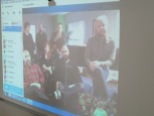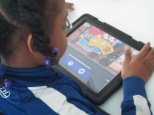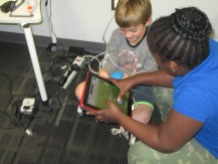It’s almost 2015! Many of us will make resolutions for the year, but in the education world a new calendar year most likely is a halfway point in the year. For me, it’s a great time to pause and check in on what I hoped to accomplish for the year, and think about what I still need to tackle. One of my big goals for the 2014-2015 school year was to “engage in global thinking and global collaboration”.
So far this year:
- We collaborated with multiple schools for International Dot Day and used Google Drawing to create works of art with our collaborating schools.
- We beta tested Wandoo Reader for Evanced and held Skype sessions to offer feedback on improving the tool for schools.
- We exchanged our recycling problem with multiple schools during America Recycles week and brainstormed solutions for one another, while realizing that we all have recycling challenges as well as ideas for both recycling and reusing.
- Our 4th grade pushed their explorers project out to the global audience and invited people to view and vote on the explorer perspectives that were offered
- Joyce Valenza and I hosted a GlobalTL Google Hangout to encourage librarians to push the start button on global collaboration through multiple online communities including the GlobalTL Google Plus Community
What I know: I still have a lot of work to do! While I’ve had many collaborative experiences, I still feel like I’m just scratching the surface of something that could be much bigger and meaningful. I also know that I have lots of ideas, but I can’t expand those ideas alone. I need my professional learning network of global librarians to think, plan, and create with me.
Joyce Valenza and I will be hosting the 1st TL Virtual Cafe of 2015 on January 5th at 8PM EST. During our session, we plan to outline three levels of global collaboration.
This process might happen as a three-level taxonomy:
- Introduction: We learn to use the tools for connection and share their affordances with learners, through engaging, though often one-shot, activities, like__Mystery Skypes__.
- Inquiry: Guided by teachers and librarians, students engage in authentic partnerships to address issues and problems, engaged in curricular projects like__Flat Classroom__.
- Independence: Students transfer use of the tools and strategies we’ve modeled, using hashtags to identify global experts, setting up their own investigatory conversations and events. They become citizen journalists, scientists, collaborative writers and creators, engaging in such projects as our Eyes Wide Open initiative.
Our children deserve teachers and librarians who are global. TLs who can plan meaningful global learning partnerships, connecting learners, classrooms and libraries through inquiry projects and expanding the possibilities of expanding the books we read.
Join us for what we hope will be a global conversation. We want this TL Cafe to not just be a presentation of success, but instead have it be an opportunity to ponder what we’ve tried and brainstorm new ideas for what we can do together as teacher librarians around the world.
Plan to join us. Bring your ideas and be ready to share them in the chat, on Twitter, and even on the mic during the session. See you there!













































































































































































































































































